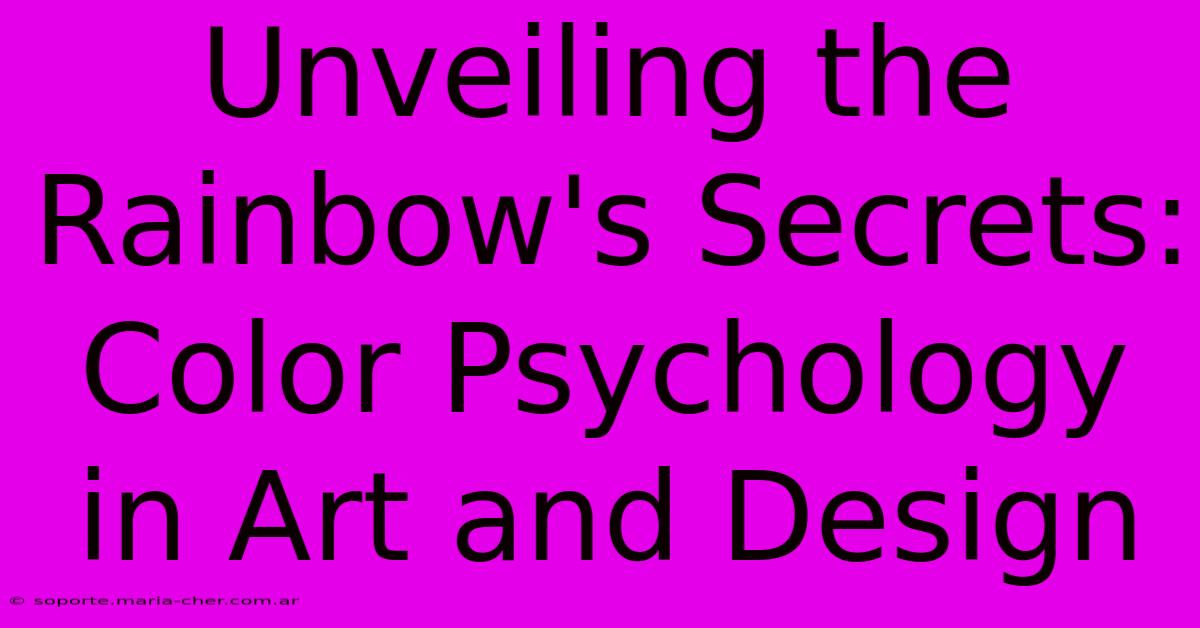Unveiling The Rainbow's Secrets: Color Psychology In Art And Design

Table of Contents
Unveiling the Rainbow's Secrets: Color Psychology in Art and Design
Color. It's more than just a pretty sight; it's a powerful tool that evokes emotions, influences decisions, and shapes our perception of the world. Understanding color psychology is crucial for artists and designers alike, allowing them to wield this potent force to achieve specific effects and communicate effectively. This article delves into the fascinating world of color psychology, exploring how different hues impact our minds and how this knowledge can be harnessed in art and design.
The Psychology of Hue: Understanding Color's Impact
The impact of color is deeply rooted in our biology and cultural experiences. Certain colors trigger instinctive responses, while others carry learned associations. Let's explore some key examples:
Red: Passion, Energy, and Urgency
Red is a vibrant, attention-grabbing color often associated with passion, energy, excitement, and urgency. Think of stop signs, fire engines, and Valentine's Day hearts – all utilizing red to convey a strong message. In design, red can be used to create a sense of excitement or to highlight important calls to action. However, overuse can lead to feelings of aggression or anxiety.
Blue: Calm, Trust, and Stability
In stark contrast to red, blue evokes feelings of calm, trust, and stability. Often associated with the sky and the sea, blue projects an image of serenity and reliability. Businesses frequently use blue in their branding to convey professionalism and trustworthiness. Different shades of blue can vary in their effects, with darker blues appearing more sophisticated and lighter blues feeling more approachable.
Green: Nature, Growth, and Harmony
Green, the color of nature, is associated with growth, harmony, and freshness. It represents renewal and peace, often used to create a calming and natural atmosphere. In design, green can be used to evoke feelings of tranquility or to connect with eco-conscious consumers.
Yellow: Happiness, Optimism, and Creativity
Yellow is a cheerful and vibrant color associated with happiness, optimism, and creativity. It's often used to create a sense of warmth and energy. However, excessive yellow can become overwhelming and even irritating.
Orange: Enthusiasm, Creativity, and Playfulness
Orange blends the energy of red with the happiness of yellow, resulting in a color that exudes enthusiasm, creativity, and playfulness. It's often used to create a sense of fun and excitement.
Purple: Royalty, Luxury, and Spirituality
Purple, historically associated with royalty, often conveys luxury, sophistication, and spirituality. Its rich hues can add a sense of grandeur and mystique to a design.
Black and White: Contrast and Sophistication
Black and white, while not technically colors, are essential elements in design. Black represents power, sophistication, and mystery, while white signifies purity, simplicity, and elegance. The contrast between black and white can be a powerful design tool.
Applying Color Psychology in Art and Design
Understanding these basic color associations is only the first step. The effective use of color psychology requires considering:
- Color Combinations: The interplay between colors creates different moods and effects. Complementary colors (opposite each other on the color wheel) create high contrast, while analogous colors (adjacent on the color wheel) produce a harmonious feel.
- Color Saturation and Brightness: The intensity and lightness of a color significantly affect its impact. Muted tones create a calm atmosphere, while bright colors are more stimulating.
- Cultural Considerations: Color associations can vary significantly across cultures. What is considered lucky in one culture might be unlucky in another. Careful research is essential when designing for a global audience.
Conclusion: Harnessing the Power of Color
Color is a powerful communication tool. By understanding the psychological impact of different colors and mastering the art of color combination and application, artists and designers can create truly impactful and effective work. Mastering color psychology is not just about aesthetics; it's about understanding the human response and using that knowledge to connect with your audience on a deeper level. The rainbow holds many secrets, and unlocking them can transform your creative process.

Thank you for visiting our website wich cover about Unveiling The Rainbow's Secrets: Color Psychology In Art And Design. We hope the information provided has been useful to you. Feel free to contact us if you have any questions or need further assistance. See you next time and dont miss to bookmark.
Featured Posts
-
The Golden Standard Eye Catching Gold Foil Nail Designs That Will Turn Heads
Feb 09, 2025
-
Shimmering Silver Exploring The Mystical Allure Of Winnies Icy Exterior
Feb 09, 2025
-
The Power Of Contrast Creating Visual Interest Through Color
Feb 09, 2025
-
Vibrant Hues And Flowing Strokes 6 Mind Blowing Tips For Watercoloring That Will Make Your Art Soar
Feb 09, 2025
-
Meniscus Operation Cost What You Need To Know Before Surgery
Feb 09, 2025
